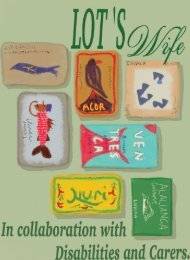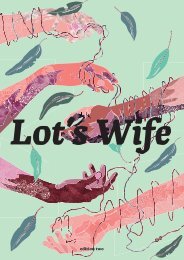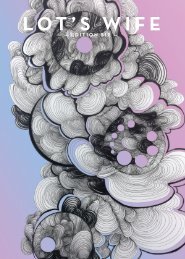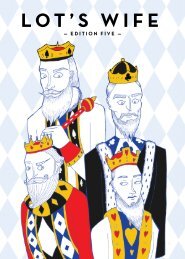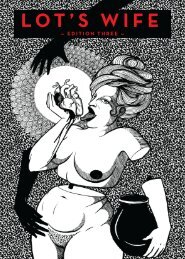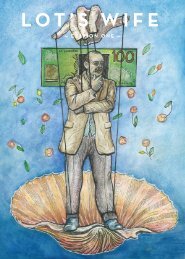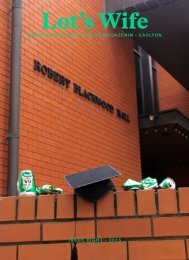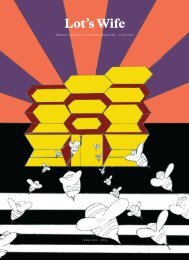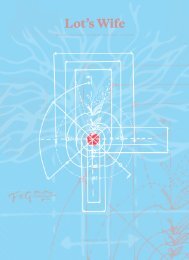Lot's Wife Edition 1 2021
You also want an ePaper? Increase the reach of your titles
YUMPU automatically turns print PDFs into web optimized ePapers that Google loves.
Lot’s <strong>Wife</strong> • <strong>Edition</strong> One<br />
Queensland State Success Continues<br />
for Labor in Face of Federal Failures<br />
Words by Pat Callanan<br />
The Labor Party has continued its dominance in Queensland<br />
with its victory in last year’s state election, despite its consistently<br />
poor federal election record. The Liberal National<br />
Party’s (LNP) loss on October 31 to the incumbent Palaszczuk<br />
Labor Government means it has only won one out of twelve<br />
elections in the state since 1989, that being in 2012.<br />
resulted in the jailing of the Queensland Police Commissioner<br />
and three government ministers. The Inquiry also led to<br />
the resignation of Queensland Premier Joh Bjelke-Petersen,<br />
whose 19 years in power became synonymous with corruption<br />
and authoritarianism.<br />
Joh Bjelke-Petersen, the National Party leader and<br />
Queensland Premier from 1968-1987, remains a spectre of<br />
corruption in Queensland politics. PHOTO: Wikimedia Commons.<br />
Associations with this period have hindered the Liberal-National<br />
parties from returning to power at a state level, Dr<br />
Salisbury said.<br />
The LNP/Coalition has won more seats than Labor in the<br />
Queensland Parliament only once since 1989. DATA SOURCE:<br />
Electoral Commission Queensland. Interactive Chart Link<br />
University of Queensland political historian Chris Salisbury<br />
said a major reason for Labor’s long-term success at a<br />
state level are the negative associations with conservative<br />
Queensland state governments.<br />
“We’re seeing today a reappearance… of very conservative,<br />
sort-of religious fundamentalism appear in parts of the LNP in<br />
Queensland,” Dr Salisbury said.<br />
“I think that still leaves a taint on the conservative side of politics<br />
in this state that leaves a lot of voters, and probably older<br />
voters, with a real unease about returning the parties of that<br />
time to government,” Dr Salisbury said.<br />
Dr Salisbury said that unease was reinvigorated by the LNP<br />
Newman Government from 2012-2015. After winning 78 seats<br />
and reducing Labor to only seven seats in the Queensland<br />
Parliament in the 2012 state election, the Newman Government<br />
was spectacularly defeated after one term in 2015.<br />
“We’ve now seen three elections where the Labor Party campaigns<br />
on the opposition or its leader being somehow associated<br />
with that period of government and some of the excesses<br />
that we saw here during that time,” Dr Salisbury said.<br />
“I think for most Queenslanders that is now something of a<br />
turn-off, and it just brings back echoes of the past authoritarian<br />
and very moralising government that we had here more<br />
than thirty years ago,” he said.<br />
The Liberal and National parties governed Queensland from<br />
1957-89 until being engulfed in a widespread corruption<br />
scandal and voted out of office.The landmark 1987 Fitzgerald<br />
Inquiry (Commission of Inquiry into Possible Illegal Activities<br />
and Associated Police Misconduct) resulted in the<br />
jailing of the Queensland Police Commissioner and three<br />
government ministers. The Inquiry also led to the resignation<br />
of Queensland Premier Joh Bjelke-Petersen, whose 19 years<br />
in power became synonymous with corruption and authoritarianism.<br />
Monash University Associate Professor of Politics Paul Strangio<br />
said it is also not uncommon for Labor Governments to be<br />
preferred at a state level across Australia.<br />
“[Voters] almost prefer state Labor governments for service<br />
delivery purposes, because that by and large is the role of<br />
state governments,” he said.<br />
Labor’s success in the state contrasts sharply with its performance<br />
in Queensland at a federal level, where it received a<br />
twenty-year low 26.68 per cent of the state’s primary vote at<br />
the 2019 federal election.<br />
54




